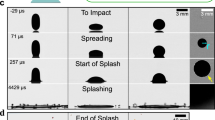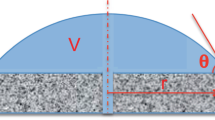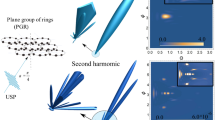Abstract
The characterization of short-wavelength scattering phenomena has been advanced by the study of diffraction catastrophes1,2. Examples include optical phenomena1–5 and molecular collisions6. The most familiar example of a diffraction catastrophe is the ordinary rainbow7–9. The angular variation of the scattering from a spherical drop locally corresponds to that of a fold-diffraction catastrophe1,2, a result most clearly seen with monochromatic illumination. We have studied the scattering from drops whose shape closely approximated that of an oblate spheroid with the short axis—the symmetry axis—vertical. The drops were illuminated by a horizontally propagating gaussian beam with a wavelength λ = 633 nm. These drops were observed to scatter in the horizontal rainbow region with patterns like those of hyperbolic–umbilic (classification D +4) diffraction catastrophes1,5,6. Visible D+4 diffraction patterns observed previously include light transmitted by frosted glass surfaces10 and by liquid lenses clinging to tilted glass plates1,4.
This is a preview of subscription content, access via your institution
Access options
Subscribe to this journal
Receive 51 print issues and online access
$199.00 per year
only $3.90 per issue
Buy this article
- Purchase on Springer Link
- Instant access to full article PDF
Prices may be subject to local taxes which are calculated during checkout
Similar content being viewed by others
References
Berry, M. V. & Upstill, C. in Progress in Optics Vol. 18 (ed. Wolf, E.) 257–346 (North-Holland, Amsterdam, 1980).
Berry, M. V. in Physics of Defects (eds Balian, R., Kléman, M. & Poirier J.-P.) 453–543 (North-Holland, Amsterdam, 1981).
Berry, M. V. & Nye, J. F. Nature 267, 34–36 (1977).
Nye, J. F. Phil. Trans. R. Soc. A292, 25–44 (1979).
Gilmore, R. Catastrophe Theory for Scientists and Engineers (Wiley, New York, 1981).
Uzer, T., Muckerman, J. T. & Child, J. T. Molec. Phys. 50, 1214–1230 (1983).
Van de Hulst, H. C. Light Scattering by Small Particles (Wiley, New York, 1957).
Khare, V. & Nuzzenzveig, H. M. Phys. Rev. Lett. 33, 976–980 (1974).
Konnen, G. P. & deBoer, J. H. Appl. Opt. 18, 1961–1965 (1979).
Berry, M. V. J. Phys. A8, 566–583 (1975).
Hanson, A. R., Domich, E. G. & Adams, H. S. Rev. scient. Instrum. 35, 1031–1034 (1964).
Marston, P. L., LoPorto-Arione, S. E. & Pullen, G. L. J. acoust. Soc. Am. 69, 1499–1501 (1981); 71, 511–512 (1982).
Marston, P. L. Appl. Opt. 19, 680–685 (1980).
Fraser, A. B. J. opt. Soc. Am. 73, 1626–1628 (1983).
Green, A. W. J. appl. Met. 14, 1578–1583 (1975).
Author information
Authors and Affiliations
Rights and permissions
About this article
Cite this article
Marston, P., Trinh, E. Hyperbolic umbilic diffraction catastrophe and rainbow scattering from spheroidal drops. Nature 312, 529–531 (1984). https://doi.org/10.1038/312529a0
Received:
Accepted:
Issue Date:
DOI: https://doi.org/10.1038/312529a0
This article is cited by
-
Gravitational caustics in an atom laser
Nature Communications (2021)
-
Sharp scattering spectra induced brilliant and directional structural colors
Science China Materials (2021)
-
A time-resolved glimpse of the terahertz glory
Nature (1998)
-
Earthquake modeling: Caustics in seismology
Nature (1986)
-
Rainbow scattering from spheroidal drops—an explanation of the hyperbolic umbilic foci
Nature (1984)
Comments
By submitting a comment you agree to abide by our Terms and Community Guidelines. If you find something abusive or that does not comply with our terms or guidelines please flag it as inappropriate.



